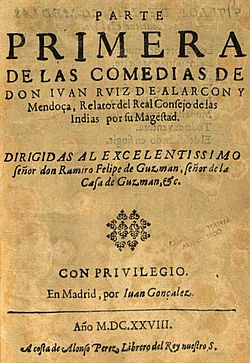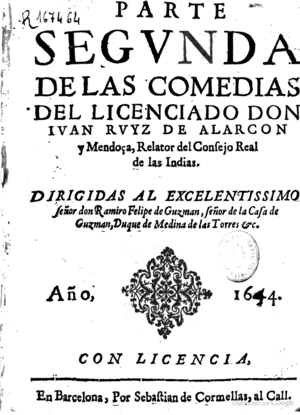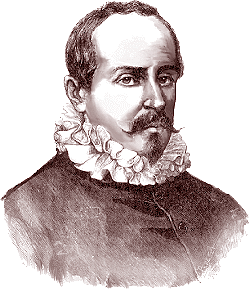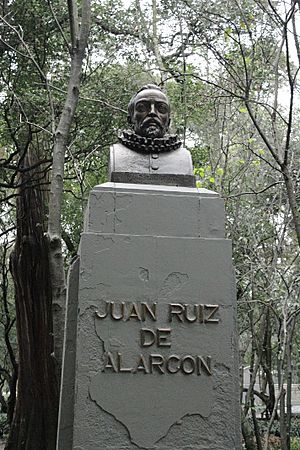Juan Ruiz de Alarcón facts for kids
Quick facts for kids
Juan Ruiz de Alarcón
|
|
|---|---|
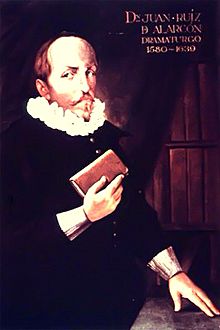 |
|
| Born |
Juan Ruiz de Alarcón y Mendoza
c. 1580 |
| Died | August 4, 1639 (aged 58–59) |
| Occupation | writer, actor, and lawyer |
| Signature | |
 |
|
Juan Ruiz de Alarcón (born around 1581 – died August 4, 1639) was an important writer from New Spain (what is now Mexico). He lived during the Spanish Golden Age, a time when Spanish art and literature were at their best.
Juan Ruiz de Alarcón wrote many different kinds of plays. His comedy La verdad sospechosa (The Suspect Truth) is a famous work. It is considered a masterpiece of Latin American theater from the Baroque period.
Contents
Juan Ruiz de Alarcón's Family Background
Juan Ruiz de Alarcón was born in a place called Real de Taxco. This town was later renamed Taxco de Alarcón to honor him.
His family came from an old noble background in Asturias, Spain. The name Alarcón was given to an ancestor, Ferren Martínez de Ceballos. This happened after he successfully helped drive the Moors from a fortress in Alarcón in 1177.
Juan Ruiz de Alarcón's grandparents, Hernando and María de Mendoza, were among the first Spaniards to arrive in Mexico in 1535. They settled in Taxco. Their daughter, Leonor de Mendoza, married Pedro Ruiz de Alarcón. Pedro was known as an hidalgo, which meant he was a person of minor nobility.
Juan Ruiz de Alarcón had four brothers:
- Pedro Ruiz de Alarcón, who was a leader at the College of Saint John Lateran.
- Hernando Ruiz de Alarcón, who was a priest. He wrote a book about the non-Christian religious practices of the Nahua people in central Mexico.
- Gaspar and García, about whom not much is known.
Juan Ruiz de Alarcón's Life Story
Juan Ruiz de Alarcón was born around 1581 in Real de Taxco, New Spain. His father managed mines there. His mother's family, the Mendozas, was very well-known in Spain.
Juan was small and had a hunchback. He also had red hair. Sometimes, people made fun of his appearance. This was because some people at the time had a prejudice that red hair was a sign of bad character. Because of this, his critics sometimes made fun of how he looked instead of talking about his plays.
He moved to Spain in 1600. There, he studied law at the University of Salamanca. He continued his studies and finished a Licentiate in Law in 1605. This degree is similar to a master's degree today.
After his studies, he worked as a lawyer in Seville for a while. In 1608, he returned to Mexico. In 1609, he received his licentiate from the University of Mexico. He also finished his studies for a doctorate. However, he never got the degree because the ceremony was very expensive.
He worked as a legal advisor and a judge. He also tried many times to get a teaching job at the University, but he was not successful.
Around 1611, he went back to Spain. He started working for the Marquis de Salinas. He also began writing plays to earn money. His first play, El semejante de sí mismo, was not a big success. However, it did make people notice him. Some people made fun of him, but others supported him.
For ten years, he balanced his legal work and his writing. Finally, in 1626, he got a permanent job at the Royal Council of the Indies. This council was like an appeals court for the Spanish colonies in America.
Once he had this important job, he mostly stopped writing plays. He did publish two collections of his plays in 1628 and 1634. This might have been because some of his plays were being copied and published under other writers' names, like Félix Lope de Vega. Juan Ruiz de Alarcón died in Madrid in 1639, after working for the Spanish crown for thirteen years.
Juan Ruiz de Alarcón's Plays and Importance
Juan Ruiz de Alarcón wrote fewer plays than other famous Spanish writers of his time. He was also one of the few great writers from the Siglo de Oro (Golden Age) who was born in Spanish America. He took great care to plan and perfect his plays.
A famous expert named James Fitzmaurice-Kelly once said about Alarcón: "There are Spanish dramatists greater than Ruiz de Alarcón: there is none whose work is of such even excellence." This means that while others might have written more, Alarcón's plays were always of high quality.
He wrote about twenty-five plays. Twenty of these were published by him in two books.
- The first book, from 1628, had eight plays.
- The second book, from 1634, had twelve plays.
Other plays were published in different collections.
His most famous play is La verdad sospechosa (The Suspect Truth), published in 1634. A very important French comedy, Corneille's Le menteur (The Liar), was based on Alarcón's play. Another play, Las paredes oyen (Walls Have Ears), is often seen as a partner to La verdad sospechosa. Both plays deal with the topic of lying.
Alarcón's plays can be put into different groups:
- Social comedies: These plays often show funny situations about people and society.
- Political dramas: These plays deal with rulers and government. For example, El dueño de las estrellas is a sad play about Lycurgus, a famous lawgiver from ancient Sparta. Another political play, La amistad castigada, is unusual because the king is removed from power at the end.
- Plays about magic and the occult: These plays include amazing stories about magic, which was a sensitive topic at the time. Examples are La cueva de Salamanca and La prueba de las promesas. The play Quien mal anda, mal acaba might be the first Spanish play about making a deal with the devil. Even in his social comedies, like Las paredes oyen, you can find mentions of astrology.
Alarcón cared a lot about teaching good lessons in his plays. His plays are known for their lively conversations and clear way of presenting stories.
Juan Ruiz de Alarcón's Works
Plays in Verse
- La verdad sospechosa (Suspect Truth)
- Los favores del mundo
- La industria y la suerte
- Las paredes oyen (The Walls Have Ears)
- El semejante a sí mismo (He Who is Similar to Himself)
- La cueva de Salamanca (The Cave in Salamanca)
- Mudarse por mejorarse
- Todo es ventura
- El desdichado en fingir
- Los empeños de un engaño
- El dueño de las estrellas (The Master of the Stars)
- La amistad castigada (Friendship Punished)
- La manganilla de Melilla (The Stratagem at Melilla)
- Ganar amigos
- El anticristo (The Antichrist)
- El tejedor de Segovia (The Weaver from Segovia)
- La prueba de las promesas (Trial through Promises)
- Los pechos privilegiados
- La crueldad por el honor
- El examen de maridos (The Test of Suitors)
- Quien mal anda en mal acaba (He Who Follows an Evil Way Ends Evilly)
- No hay mal que por bien no venga
- La Monja Alférez (The Nun Lieutenant), based on Catalina de Erauso
Other Writings in Verse
- Una redondilla y cuatro décimas sobre el asunto que luego se verá
- Vejamen académico a Bricián Díez Cruzate, cuando se doctoró en la Universidad de México (1609-1613)
- Décima del licenciado don Juan Ruiz de Alarcón, natural de México
- Romance contra don Francisco de Quevedo
- El licenciado don Juan Ruiz de Alarcón y Mendoza a don Diego Agreda y Vargas
- Al doctor Cristóbal Pérez de Herrera, el licenciado don Juan Ruiz de Alarcón y Mendoza
- A don Gonzalo de Céspedes y Meneses, el licenciado don Juan Ruiz de Alarcón y Mendoza
- Al Santo Cristo que se halló en Prete, ciudad del Palatinado inferior, quitado de la Cruz y hecho pedazos por los calvinistas, restaurado por los católicos, el licenciado Juan Ruiz de Alarcón dirige estos sonetos
- De don Juan Ruiz de Alarcón en la muerte del Conde de Villamedina (21 de agosto de 1622)
- Elogio descriptivo a las fiestas que Su Majestad del rey Filipo IIII hizo por su persona en Madrid, a 21 de agosto de 1623 años, a la celebración de los conciertos entr el serenísimo Carlos Estuardo, Príncipe de Inglaterra, y la serenísima María de Austria, Infanta de Castilla, al Duque Adelantado & c.
- El licenciado don Juan Ruiz de Alarcón y Mendoza, al mismo (José Camerino)
- Al volcán en incendios del Vesubio, el licenciado don Juan Ruiz de Alarcón y Mendoza, Relator del Consejo de Indias. Epigrama XXIX
- Sonero dedicado al mismo asunto que el anterior
- Sátira contra don Francisco de Quevedo
- El licenciado don Juan Ruiz de Alarcón y Mendoza, Relator del Consejo de las Indias. Al autor. Décimas
See also
 In Spanish: Juan Ruiz de Alarcón para niños
In Spanish: Juan Ruiz de Alarcón para niños



